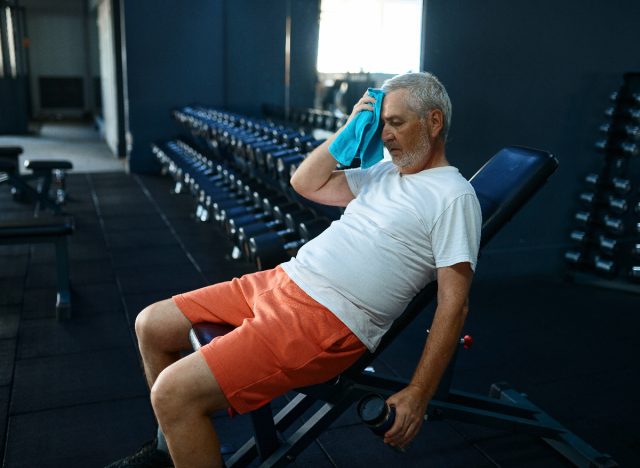Some people think that because they go to the gym every day to work out, they are doing wonders for their body. That may be true, but did you know that there are also very bad exercise habits that destroy your arms after 50? We spoke with Mike Bohl, MD, MPH, ALM, a member of our Medical Expert Council, and get the inside scoop. Read on to find out what you might be doing wrong and how to fix these mistakes that are wreaking havoc on your arms.
Working on keeping your arms strong is so important as you get older. You might be surprised to learn that your muscle strength and muscle mass peak around the age of 30 to 35, National Institute of Aging reports. You still have many years ahead of you and it is important to exercise and keep your limbs in top shape. Just think about how much arm strength you use for tasks you do every day, like reaching for things in a closet, carrying your own groceries in and out of the car, lifting your dog into the car for a the vet, and push you out of a chair.
Needless to say, arm day at the gym is essential. But it’s equally important to be aware of the mistakes you might be making that can negatively impact your arms as you age. Dr. Bohl breaks down some of the worst exercise habits that are destroying your arms after 50, so keep reading to find out what they are. And then be sure to check out 9 Exercise Habits That Are Destroying Your Back After 50.

Some exercises may seem like arm workouts, but they really aren’t. A perfect example is exercising on a rowing machine, where the majority of the force you use when stepping back should come from the motion of leaning back and straightening both legs, not pulling forcefully using your arms, explains the Dr Bohl.

We all know that exercising is pure goodness for your physical and mental health, but it also puts a lot of strain on your body. It’s very easy to overtrain your arms without knowing it.
Dr. Bohl warns: “If you lift too much too often, you put a lot of pressure on your muscles and bones, which will eventually lead to fatigue, weakness and the need to take longer to lift. retrieve.”

If you don’t take enough time to rest between the sets you perform during workouts or between workout days, you are putting yourself at risk. Dr. Bohl points out, “If you’re doing back-to-back arm exercises, you might be more at risk of injury.”
You might be inclined to skip rest days, but do yourself a favor and give your body the break it needs. It is a necessary step! According Medical News Todayrest days help repair and sculpt your muscles, relieve muscle aches or pains, restore your body’s energy, and give your mind some time to relax.

Several arm conditions are quite common, including tennis elbow, a rotator cuff tear, or carpal tunnel syndrome. “If you have a current arm condition, you should avoid certain exercises that could make these conditions worse. For example, with a torn rotator cuff, you need to think about how you move your shoulder, such as avoiding raise your arm above your head,” advises Dr. Bohl.

You may not think that posture can have a major impact on your workouts, but whenever you train, maintaining solid form and posture is key. According to Dr. Bohl, “In general, you should check all five kinetic chain checkpoints – your feet and ankles, your knees, your hips and pelvis, your shoulders and your head. Specifically for the arms, you want to avoid rounding your shoulders forward or elevating and you want to keep your head facing forward in a neutral position with the ears in line with the center of the shoulder.”

It’s essential for your muscles to repair themselves after a workout, which requires feeding them with nutrients. “Therefore, even if you’re on a diet, it’s important to eat enough carbs and protein after a workout and throughout the day, so your muscles can recover and be ready again for your next workout. workout,” says Dr. Bohl.
According Medical News TodayEating carbohydrates and protein, as well as drinking water within two hours of finishing moderate or intense exercise can help your body regain its energy levels.

There are several popular arm exercises, such as bicep curls, that focus on one muscle. However, your body usually doesn’t use one muscle at a time. This is why Dr. Bohl recommends performing compound exercises. He says: “In general, it’s best to do compound exercises that use multiple muscle groups at the same time, including the stabilizing muscles. Compound arm movements include hammer curls, rows, chest presses, shoulder presses and pull-ups.”

